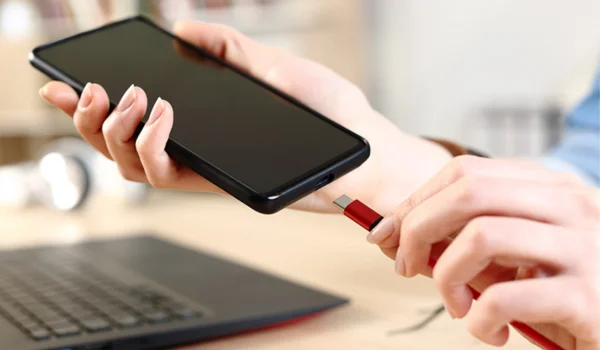Can I Charge My Phone with a Laptop Charger? Here’s What You Need to Know
In today’s tech-savvy world, most of us carry multiple devices — phones, laptops, tablets, power banks — and all of them need to be charged regularly. So, it’s not surprising that one of the most common questions people ask is:
“Can I charge my phone with a laptop charger?”
If you’ve ever found yourself stuck with a low phone battery and your phone charger is nowhere in sight, but your laptop charger is USB-C, you’ve probably wondered whether it’s safe to plug in your phone.
As a phone expert and someone who has tested this with various devices (Samsung, iPhone, OnePlus, Xiaomi, etc.), I’m here to explain when it’s safe, when it’s not, what you should look out for, and how to do it the right way.
✅ Short Answer: Yes, But With Conditions

Yes, you can charge your phone with a laptop charger, if both your phone and laptop charger use USB-C, and your charger supports USB Power Delivery (PD). However, there are a few important things you need to understand before doing so.
Let’s break it down.
🔌 USB-C: The Common Connector
Most modern phones and laptops now use USB-C, which is a universal charging and data transfer standard. USB-C connectors are reversible, compact, and powerful — capable of carrying high wattage.
If your laptop charger has a USB-C connector and your phone also uses USB-C, then charging is technically possible. But wattage and voltage matter too.
⚠️ Check the Power Output (Wattage)
Laptop chargers, especially from brands like Apple, Dell, Lenovo, and HP, often deliver high power output — 45W, 60W, 65W, 100W, or even 140W. In contrast, most smartphones are designed to charge at much lower wattages — typically 5W to 30W.
Will high wattage damage your phone?
No, not necessarily. Modern USB-C Power Delivery (PD) technology allows the device to negotiate power needs. This means your phone will only draw as much power as it needs — say 18W — even if the charger can provide 65W.
So, as long as your charger supports PD, and your cable is high-quality, it’s safe.
📌 Example: I used my MacBook Air’s 30W USB-C charger to charge my OnePlus Nord. It worked perfectly, although it didn’t fast charge like the original phone charger.
🛠️ When It May NOT Be Safe
While it generally works well, here are a few scenarios where it can be risky:
- Using USB-A to USB-C cables from laptop adapters not designed for phones — they may lack PD support and can cause slow charging or even battery wear.
- Using cheap third-party or unbranded chargers that don’t have safety chips to regulate power.
- Older phones that don’t support USB-C PD might heat up or charge improperly if the voltage isn’t controlled.
- Laptops with proprietary charging tips (like older Lenovo, Dell) are not USB-C and won’t work for phones at all.
💡 Things to Check Before Charging
| Item | What to Check |
|---|---|
| Charger Type | USB-C with PD support |
| Output Wattage | Between 18W and 30W is ideal, up to 60W is generally okay |
| Cable Quality | Use an original or certified USB-C cable (USB-IF certified) |
| Phone Compatibility | Ensure your phone supports USB-C PD (most new phones do) |
📱 Brand-Specific Advice
- Samsung: Most new Galaxy phones (S20, S21, S22, A-series) support PD charging. Works well with 25W–65W laptop chargers.
- iPhone: iPhone 8 and newer support USB-C PD charging, but you’ll need a USB-C to Lightning cable. Works well with Apple’s 20W/30W/61W chargers.
- OnePlus: OnePlus uses its own Warp/Dash Charge, which doesn’t work on standard PD. You’ll get slower charging speeds with a laptop charger.
- Xiaomi/Redmi: PD charging supported in many models. Laptop chargers usually work fine.
- Realme/Vivo/Oppo: Most models support VOOC or fast charge protocols. Laptop chargers will work, but fast charging may not.
🔄 Charging Speed: What to Expect?
Using a laptop charger might not deliver the fastest charge unless your phone supports the same protocol. Here’s what I experienced personally:
| Phone Model | Laptop Charger | Charging Speed |
|---|---|---|
| iPhone 13 | MacBook 30W | Fast (~50% in 30 min) |
| Galaxy S21 | Dell 65W USB-C | Medium (no Super Fast Charging) |
| OnePlus Nord | Lenovo 65W PD | Normal (slower than Warp Charge) |
| Redmi Note 10 | HP 45W USB-C | Decent (up to 18W) |
🚫 Don’t Try These
- Don’t use laptop chargers with broken or frayed cables
- Avoid charging via laptop’s USB-A port — this gives only 2.5W or 5W, which is very slow
- Don’t use third-party high-wattage chargers that lack certification — could damage your phone or battery long-term
🧠 Final Thoughts
So, can you charge your phone with a laptop charger?
Yes — and in many cases, it’s a smart, safe solution. Just make sure your charger is USB-C, supports Power Delivery (PD), and you’re using a high-quality cable.
This trick has saved me multiple times when I’ve forgotten my regular phone charger at home or while traveling. With the increasing popularity of USB-C and universal charging standards, things are getting easier — but being cautious and informed is still key.
✅ Quick Summary:
- ✔️ Yes, you can charge a phone with a USB-C laptop charger
- ⚠️ Check wattage, cable quality, and power delivery compatibility
- 🚫 Avoid unknown or cheap third-party accessories
- 🔌 Don’t expect brand-specific fast charging (like Warp, VOOC)
If you’re unsure whether your laptop charger will work with your phone, drop a comment with your model, and I’ll help you check compatibility!
